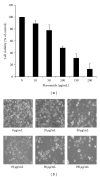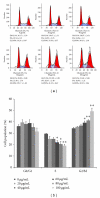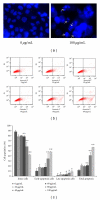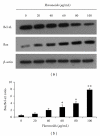Flavonoids Isolated from Korea Citrus aurantium L. Induce G2/M Phase Arrest and Apoptosis in Human Gastric Cancer AGS Cells
- PMID: 22194772
- PMCID: PMC3238396
- DOI: 10.1155/2012/515901
Flavonoids Isolated from Korea Citrus aurantium L. Induce G2/M Phase Arrest and Apoptosis in Human Gastric Cancer AGS Cells
Abstract
Aim of the Study. Citrus species is used in traditional medicine as medicinal herb in several Asian countries including Korea. Flavonioids became known as various properties, such as anti-oxidants, anti-inflammation and anti-cancer, and so forth. The present study, the anti-cancer effect of flavonioids isolated from Citrus aurantium L. in human gastric cancer AGS cells has been investigated. Materials and Methods. The anti-proliferative activity was assayed using MTT assay. Cell cycle analysis was done using flow cytometry and apoptosis detection was done using by hoechst fluorescent staining and Annexin V-propidium iodide double staining. Western blot was used to detect the expression of protein related with cell cycle and apoptosis. Results. Flavonoids isolated from Citrus aurantium L. have the effect of anti proliferation on AGS cells with IC50 value of 99 μg/mL. Flavonoids inhibited cell cycle progression in the G2/M phase and decrease expression level of cyclin B1, cdc 2, cdc 25c. Flavonoids induced apoptosis through activate caspase and inactivate PARP. Conclusions. Flavonoids isolated from Citrus aurantium L. induced G2/M phase arrest through the modulation of cell cycle related proteins and apoptosis through activation caspase. These finding suggest flavonoids isolated from Citrus aurantium L. were useful agent for the chemoprevention of gastric cancer.
Figures







Similar articles
-
Induction of the cell cycle arrest and apoptosis by flavonoids isolated from Korean Citrus aurantium L. in non-small-cell lung cancer cells.Food Chem. 2012 Dec 15;135(4):2728-35. doi: 10.1016/j.foodchem.2012.06.097. Epub 2012 Jul 6. Food Chem. 2012. PMID: 22980865
-
Flavonoids of Korean Citrus aurantium L. Induce Apoptosis via Intrinsic Pathway in Human Hepatoblastoma HepG2 Cells.Phytother Res. 2015 Dec;29(12):1940-9. doi: 10.1002/ptr.5488. Epub 2015 Oct 6. Phytother Res. 2015. PMID: 26439681
-
Flavonoids isolated from Citrus platymamma induced G2/M cell cycle arrest and apoptosis in A549 human lung cancer cells.Oncol Lett. 2016 Aug;12(2):1394-1402. doi: 10.3892/ol.2016.4793. Epub 2016 Jun 28. Oncol Lett. 2016. PMID: 27446443 Free PMC article.
-
Flavonoids isolated from Citrus platymamma induce mitochondrial-dependent apoptosis in AGS cells by modulation of the PI3K/AKT and MAPK pathways.Oncol Rep. 2015 Sep;34(3):1517-25. doi: 10.3892/or.2015.4122. Epub 2015 Jul 10. Oncol Rep. 2015. PMID: 26165353
-
A Scientometric Study to a Critical Review on Promising Anticancer and Neuroprotective Compounds: Citrus Flavonoids.Antioxidants (Basel). 2023 Mar 8;12(3):669. doi: 10.3390/antiox12030669. Antioxidants (Basel). 2023. PMID: 36978916 Free PMC article. Review.
Cited by
-
Euphorbia formosana root extract induces apoptosis by caspase-dependent cell death via Fas and mitochondrial pathway in THP-1 human leukemic cells.Molecules. 2013 Feb 1;18(2):1949-62. doi: 10.3390/molecules18021949. Molecules. 2013. PMID: 23377135 Free PMC article.
-
Korean Scutellaria baicalensis Georgi flavonoid extract induces mitochondrially mediated apoptosis in human gastric cancer AGS cells.Oncol Lett. 2017 Jul;14(1):607-614. doi: 10.3892/ol.2017.6184. Epub 2017 May 17. Oncol Lett. 2017. PMID: 28693212 Free PMC article.
-
Pectolinarigenin Induced Cell Cycle Arrest, Autophagy, and Apoptosis in Gastric Cancer Cell via PI3K/AKT/mTOR Signaling Pathway.Nutrients. 2018 Aug 8;10(8):1043. doi: 10.3390/nu10081043. Nutrients. 2018. PMID: 30096805 Free PMC article.
-
Traditional medicinal knowledge of plants used for cancer treatment by communities of mountainous areas of Fez-Meknes-Morocco.Saudi Pharm J. 2021 Oct;29(10):1185-1204. doi: 10.1016/j.jsps.2021.09.005. Epub 2021 Sep 20. Saudi Pharm J. 2021. PMID: 34703372 Free PMC article.
-
Mechanisms underlying the anti-tumoral effects of Citrus Bergamia juice.PLoS One. 2013 Apr 16;8(4):e61484. doi: 10.1371/journal.pone.0061484. Print 2013. PLoS One. 2013. PMID: 23613861 Free PMC article.
References
-
- Ghobrial IM, Witzig TE, Adjei AA. Targeting apoptosis pathways in cancer therapy. Ca-A Cancer Journal for Clinicians. 2005;55(3):178–194. - PubMed
-
- Deyhim F, Lopez E, Gonzalez J, Garcia M, Patil BS. Citrus juice modulates antioxidant enzymes and lipid profiles in orchidectomized rats. Journal of Medicinal Food. 2006;9(3):422–426. - PubMed
-
- Kim SS, Baik JS, Oh TH, Yoon WJ, Lee NH, Hyun CG. Biological activities of Korean Citrus obovoides and Citrus natsudaidai essential oils against acne-inducing bacteria. Bioscience, Biotechnology and Biochemistry. 2008;72(10):2507–2513. - PubMed
-
- Li Y, Fang H, Xu W. Recent advance in the research of flavonoids as anticancer agents. Mini-Reviews in Medicinal Chemistry. 2007;7(7):663–678. - PubMed
-
- Quílez A, Berenguer B, Gilardoni G, et al. Anti-secretory, anti-inflammatory and anti-Helicobacter pylori activities of several fractions isolated from Piper carpunya Ruiz & Pav. Journal of Ethnopharmacology. 2010;128(3):583–589. - PubMed
LinkOut - more resources
Full Text Sources

